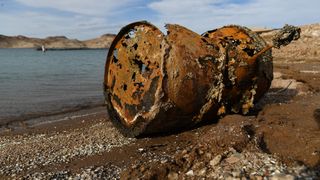Submerged human corpses rise from drought-stricken Lake Mead
The first body was found on May 1.

First the drought came. Then, the bodies started washing up.
For over a decade, water levels have been plummeting in Nevada's Lake Mead, the biggest reservoir in Clark County, Las Vegas, and one of the largest reservoirs in the United States. On May 1, receding waters due to regional drought led officials to a gruesome discovery on the reservoir's shore: a metal barrel holding a corpse that had been dumped into the water more than 30 years ago, CNN reported.
Just a few days later, more human remains emerged in Lake Mead's Callville Bay, National Park Service (NPS) representatives said in a statement. A witness reported finding "human skeletal remains" on May 7 at approximately 2 p.m. local time, and NPS rangers responded to the call and recovered the remains.
They contacted the Clark County Medical Examiner to analyze the bones, but the cause of death has yet to be determined and at the time there is "no evidence to suggest foul play," police officers told KTNV Las Vegas.
Related: Drought helped push the Vikings out of Greenland, new study finds
The clothes and footwear found on the decomposed body in the barrel suggested that the person died "sometime in the mid '70s to early '80s," Las Vegas Metropolitan Police Department (LVMPD) representatives said in a statement.
"We believe this is a homicide as a result of a gunshot wound," said LVMPD Homicide Section Lt. Ray Spencer. The victim's identity is unknown, but such information "will be released by the Clark County Coroner's Office when it becomes available," LVMPD representatives said.
Sign up for the Live Science daily newsletter now
Get the world’s most fascinating discoveries delivered straight to your inbox.
Two sisters found the second set of remains — a human jawbone with attached teeth — on an exposed sandbar while they were paddle-boarding on the lake, ABC News reported.
Lake Mead provides water for more than 40 million people across seven states and into northern Mexico; it is formed by the Hoover Dam and fed by the Colorado River, and it lies about 30 miles (48 kilometers) east of Las Vegas, according to the NPS. At maximum capacity, Lake Mead holds 9.3 trillion gallons (36 trillion liters) of water, according to NASA Earth Observatory (NEO). But the last time the reservoir was anywhere near full capacity was in 1999, and water levels have been dropping steadily ever since. Warming temperatures fueled by climate change are worsening persistent drought conditions that may be the region's worst dry spell in more than 1,000 years, NEO reported.
In August 2020, Lake Mead's waters reached only about 35% percent of its capacity. On May 9 of this year, Lake Mead's water level measured about 1,052 feet (321 meters) above sea level — roughly 162 feet (49 m) lower than in 2000, and the lowest level on record since the 1930s, CNN reported.
And with no end in sight for the punishing regional drought, more of the reservoir's long-hidden and grisly secrets may reappear from the depths, said former Las Vegas Mayor Oscar Goodman.
"There's no telling what we'll find in Lake Mead," Goodman told the Navajo-Hopi Observer. "It's not a bad place to dump a body."
Originally published on Live Science.

Mindy Weisberger is an editor at Scholastic and a former Live Science channel editor and senior writer. She has reported on general science, covering climate change, paleontology, biology, and space. Mindy studied film at Columbia University; prior to Live Science she produced, wrote and directed media for the American Museum of Natural History in New York City. Her videos about dinosaurs, astrophysics, biodiversity and evolution appear in museums and science centers worldwide, earning awards such as the CINE Golden Eagle and the Communicator Award of Excellence. Her writing has also appeared in Scientific American, The Washington Post and How It Works Magazine.
